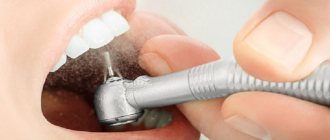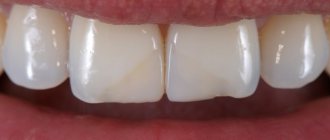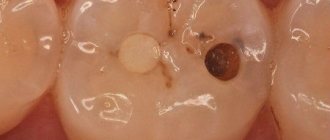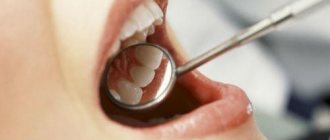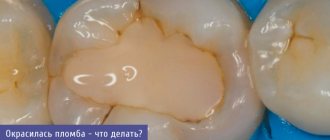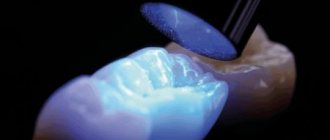The most common reason that a filling is in the way and is felt in the oral cavity is its incorrect installation. This can cause various unpleasant consequences.
Most often, an incorrectly installed filling is very easy to identify by simply closing the two jaws. If the antagonist teeth do not close together, the filling material is placed incorrectly. If the filling is placed too high, the following complications may occur:
- There will be too much load on the tooth, since the antagonist teeth will put pressure on the filling when the jaw closes. Regular pressure on a tooth can cause the development of traumatic pulpitis or even periodontitis. In this case, you will have to remove the dental nerve.
- Excessive load on the filling material can lead to chipping of the dental unit, that is, not only the filling can be damaged, but also the tooth itself.
- If the jaws close only on one side, over time, this can lead to the development of malocclusion.
Symptoms
Visiting the dentist and getting dental treatment is accompanied by unpleasant sensations and discomfort. Pain can and should be present after therapeutic measures. But it goes away after a short period of time.
If pain persists, then under no circumstances should it be ignored. They will lead to the development of inflammatory processes. The result is a damaged tooth.
Signs of an incorrectly installed seal include:
- Inability to clench or clench teeth. It feels like the filling is too high and protrudes above all the teeth. Therefore, when chewing or moving the jaw, there is a feeling of a foreign object in the mouth.
- A feeling of pain that intensifies when chewing. It occurs due to both over- and under-inflated fillings.
- Sharp or overhanging edges. The filling may have a tight fit to the bite, but at the same time cause injury to the gums or tongue. These injuries can lead to the development of stomatitis.
- Permanent injury to the papilla. This is caused by incorrect actions of the dentist, who did not preserve the interdental gaps during treatment. As a result, it becomes difficult to brush your teeth and your gums begin to bleed.
The norm is the presence of discomfort and pain in the first 3-4 days after dental treatment. Everything should go away on its own after this period. But if the discomfort persists, then you should immediately contact your dentist so that he can eliminate this problem. Most often this takes a few minutes and does not require additional intervention.
Measures to help prevent temporary fillings from falling out
In order not to think about what to do if a temporary filling falls out, try to prevent such a situation after its installation. To do this you need to adhere to the following rules:
- in the first 2 hours after installation, refrain from eating any food so that the materials finally harden and acquire the desired shape,
- exclude hard foods, nuts, and sticky foods from your diet: temporary fillings are softer than permanent fillings, they can easily crumble, break off or fall out,
- try to chew on the side opposite to the one where the treatment was carried out,
- refuse to use irrigator and floss in the area of localization of temporary materials,
- Carefully inspect the seal every day for chips and cracks: if even small leaks appear, you should consult a doctor.
Eliminate solid foods from your diet
As you can see, there is nothing difficult about keeping a temporary filling in place. If it falls out before the scheduled visit to the dentist, then there is nothing to worry about in this situation, provided that you act correctly and do not put off going to the doctor for a long time.
Notice
: Undefined variable: post_id in
/home/c/ch75405/public_html/wp-content/themes/UltraSmile/single-item.php
on line
45 Notice
: Undefined variable: full in
/home/c/ch75405/public_html/wp-content /themes/UltraSmile/single-item.php
on line
46
Rate this article:
( 7 ratings, average: 4.00 out of 5)
dental fillings
- Fedorinchik O.V. Frequency of use of calcium hydroxide preparations by dentists in the treatment of complicated caries. – Modern dentistry, 2011.
Expert “A temporary filling is not intended for long-term use, so if the doctor installs it, he must inform the patient when the next visit to the clinic needs to be made for removal or replacement. But not all people come on the appointed day, some postpone the issue for a week or even longer - and this explains why the integrity and tightness of the material is gradually being compromised.” Dentist-therapist Elena Vladimirovna Orlova
Consulting specialist
Orlova Elena Vladimirovna
Doctor rating: 9.5 out of 10 (2) Specialization: Dentist-therapist Experience: 33 years
Causes of an incorrectly installed seal
After treating a tooth, the dentist must install a filling that will protect and isolate sensitive tissues from bacteria and microbes entering the resulting cavity.
The filling material undergoes a polymerization process and then must be properly sanded. At this stage, the doctor monitors and corrects its fit to the tooth, as well as its position relative to the gums, cheeks, and tongue.
The most common causes of toothache after a filling is installed are:
- Oversized filling.
- The solution has shrunk.
- The treatment procedure was carried out in violation.
- Inflammatory began in the canals.
- Poor quality filling material.
- Allergy.
- Incorrect diagnosis and, accordingly, treatment.
- There was an infection in the dental canals.
Let's find out why a tooth hurts after a temporary filling
To control the protruding edges of the filling material, its position relative to the rest of the teeth and the bite, the dentist uses a special coloring strip. The test is that the patient must bite it several times. If the doctor sees that there are no obstacles, then he begins polishing.
This is a very important stage, because if you make a mistake and do not notice the protruding edges of the filling, they will cause problems with chewing food and oral hygiene, which will lead to the development of negative consequences and various diseases.
What to do if the temporary basis falls out
It is necessary to fix the drug in the tooth cavity and assess the condition of the tissues before installing permanent fixation.
A filling has fallen out, what to do to avoid infection:
- rinse your mouth to remove the medication;
- contact your doctor and arrange your next consultation;
- If the canals are sealed, a piece of cotton wool with chlorhexidine can be placed inside the molar.
If a temporary filling falls out, before visiting the dental clinic you need to maintain hygiene, rinse your mouth after eating, and chew on the healthy side.
What to do
There are several ways that a new filling can cause discomfort. Among them:
- Wrong size. It may be too big or small for the tooth.
- Poorly installed and polished filling. The filling material protrudes from one side of the tooth, causing additional discomfort.
Any of these problems can lead to further tooth decay. It is better not to try to correct the situation on your own, but if you notice the first symptoms, immediately contact your dentist.
The doctor must properly sand the filling material. The adjustment will take a maximum of 5-10 minutes.
Some people are in no hurry to seek help from a specialist because they mistakenly believe that the filling itself will wear off over time and stop causing discomfort. But the modern material that dentists use is more durable. A high-quality filling will shrink and begin to wear off only after a few years.
Can arsenic harm the body?
If a nerve is inflamed, only a doctor can help. Treatment of pulpitis may include healing procedures or removal of pathological tissue. The choice depends on the stage of the lesion. If you contact the dentist right away, you can stop the inflammation process while preserving the nerve. The essence of surgical technologies is partial or complete removal of the pathological pulp.
Many patients are frightened by the loss of glue placed in the cavity of the unit for a certain period. It happens that patients accidentally swallow it. This will not lead to perforation of internal systems and organs, and the inflammatory process will not start from this. Arsenic is almost never used in the practice of modern dentists. Today, dentists are increasingly using special pastes that contain a small amount of the chemical element. The substance works as a necrotizing mixture. Such a dose is not capable of leading to poisoning.
If ingestion cannot be avoided, contact your dentist. Before seeing a doctor, call him and describe the situation to him. The doctor will tell you what actions you should take, because he is familiar with the problem. An unscheduled visit may be scheduled for re-filling. If there is no danger, the visit may take place on the previously planned day.
Doctor's actions
The dentist must act and take measures based on the reasons that led to discomfort after dental treatment. There may be several situations:
- The discomfort does not go away within several days. You should definitely visit a doctor who will polish the filling in a couple of minutes. Otherwise, negative consequences may begin to develop and tooth decay may occur.
- If the edges of the filling are too sharp, they can cause injury to the gums, tongue or cheek. In this case, you should immediately visit the dentist so that he can immediately polish the filling, thereby preventing possible injuries.
- A crack remains between the filling and the surface of the tooth. You should definitely see a doctor again, as bacteria and microbes will get into the gap that has formed, which will trigger the development of caries.
Also, do not ask the doctor to file down the filling too much. The teeth of the upper and lower jaws must be in close contact with each other while chewing food. If this does not happen, then the person’s bite will be disrupted.
Indications for installing a temporary filling
Some patients are sincerely perplexed and consider temporary filling an unnecessary measure. However, in fact, this is a very important stage in the treatment of teeth affected by deep caries, pulpitis, periodontitis, as well as in the presence of abscesses, cysts and granulomas.
The photo shows a temporary filling
The doctor resorts to temporary filling if it is not possible to carry out treatment in one stage or the inflammation needs to be eliminated. They also resort to a temporary solution while stump inlays and permanent prostheses are created for the patient in the laboratory. The filling serves as protection against external factors and bacteria. It prevents medications and antiseptics from coming out, which are placed inside the root canals and have a therapeutic effect.
“The doctor gave me a temporary filling just to see how the tooth would behave and whether complications would begin after treatment of deep caries. I carried it for about 5 days with severe pain, and then it fell out, after which the doctor said that we would remove the nerve from the tooth...”
Nadezhda, review from yell.ru
Possible consequences
If the dentist installed the filling incorrectly, and the patient is afraid or does not want to go back to fix this problem, then there is a high probability of negative consequences developing. These include:
- Pulpitis and periodontitis. They are the result of an over-inflated filling. That is, there is constant and strong pressure on the tooth, which leads to chronic injury. Because of this, the enamel on a person’s teeth wears off, which leads to the re-formation of caries. If the filling is not corrected in a timely manner, the tooth will have to be depulped.
- Chipped tooth surface. It also occurs due to constant pressure on the tooth that has been filled.
- Dislocation. It can happen if, when closing the mouth, the teeth close unevenly and incorrectly on different sides. In other words, a misalignment occurs and pathology of the temporomandibular joints develops. The main signs of this problem are: pain, crunching, clicking.
After the treatment, it is very important how the dentist filled the tooth. If the filling begins to interfere with the motor functions of the lower jaw, then it is worth telling the doctor about this so that he can polish it again.
It’s easy to check if the filling is in the way. You just need to move your lower jaw to the right, left, forward, and also leave your mouth open. If you feel pain or discomfort, you should immediately inform your dentist so that he can fix the problem.
People who do not want to go for a second appointment mistakenly believe that over time the filling will wear off and stop causing discomfort. Of course, a feeling of addiction may arise, but it will not in any way affect the solution to the problem. You cannot do without the help of a dentist.
The sooner you re-visit the doctor and adjust the filling, the lower the risk of developing negative consequences and dental diseases.
How long is it temporary?
The period for installing such a filling depends on the purpose and clinical situation. It can range from 3 days to several months. If the doctor uses arsenic-based paste, then further treatment is carried out after 3-5 days, a maximum of a week. You cannot walk with arsenic in your tooth for any longer, as it can not only kill the nerve, but also destroy healthy tissue.
If the material used is necessary to protect against food and bacteria getting inside the canals during their sanitation or treatment of inflammation, it can remain in the tooth for several weeks. For longer treatments, the dentist may replace temporary fillings if a new dose of medication becomes necessary.
When is it time to replace an old filling?
The reason to contact a dental clinic is the appearance of the following symptoms:
- reaction of teeth to changes in food temperature;
- darkening of the enamel or the filling itself, chips, mobility;
- constant bad breath;
- bleeding, inflammation or discoloration of the gums.
The presence of secondary caries is difficult to detect during an external examination, so in dentistry a visiograph, a new generation device, is used for this purpose. He takes a picture of the tooth, and the data is processed by a computer program. Moreover, the radiation dose when using it is several times less than with a conventional x-ray examination.
What determines the service life of a filling?
As already mentioned, the average lifespan of a filling is about five years, but it is optimal to determine it individually, since it depends on a number of factors:
- Properties and characteristics of the filling material that was used;
- The dentist’s compliance with technological processes during installation;
- The condition of the unit being sealed (the degree of its destruction, the thickness of the walls);
- Hygienic measures of the oral cavity (regularity and correctness of their implementation, brushes and pastes used by the patient);
- Regular consumption of hard foods and sugar.
There are cases when, provided they are installed correctly and provided with good care, fillings can serve patients well for more than ten years.

